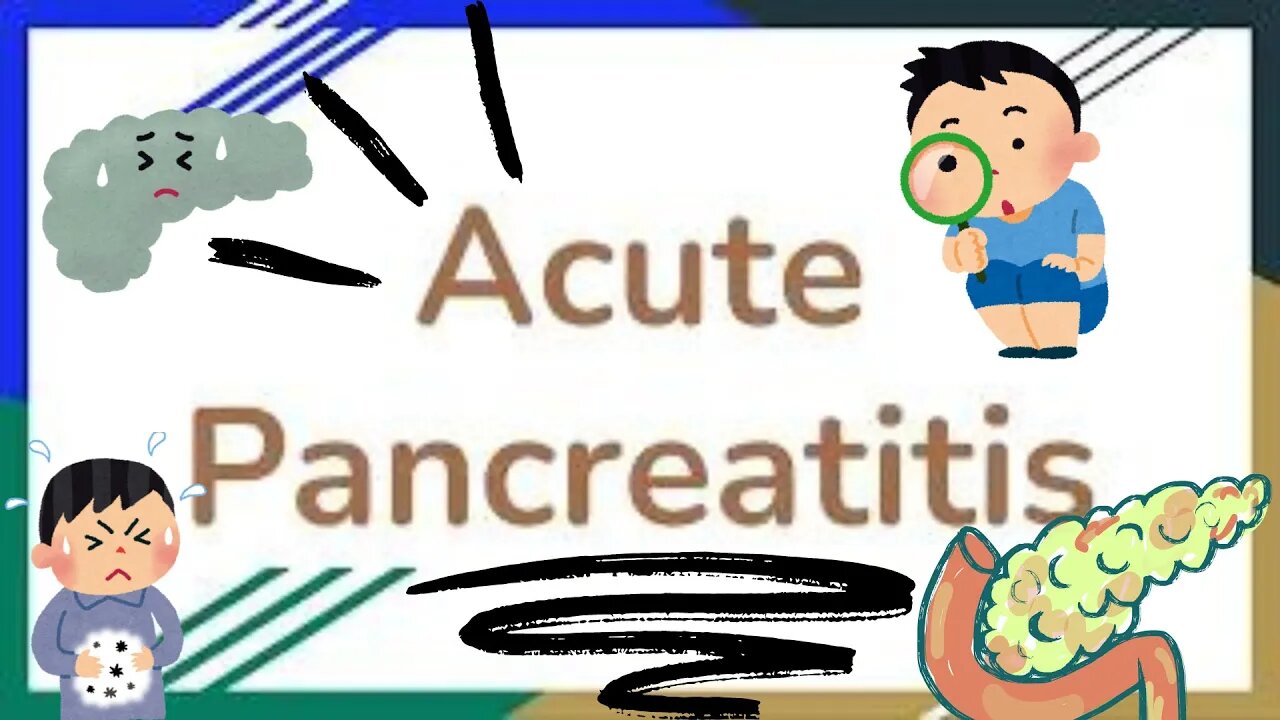Premium Only Content

Acute Pancreatitis: Comprehensive Overview | Causes, Symptoms, Diagnosis, Treatment & Complications
Acute pancreatitis is a sudden inflammation of the pancreas that can range from mild discomfort to a severe, life-threatening condition. In this video, we cover everything you need to know about acute pancreatitis, including its causes, clinical presentation, diagnosis, treatment strategies, and complications.
We will explain the pathophysiology of acute pancreatitis, discuss the risk factors and clinical signs, and walk through the diagnostic approach, including laboratory tests and imaging techniques. Treatment protocols, both medical and surgical, will be covered, as well as common complications and management strategies.
Key Topics Covered:
Introduction to Acute Pancreatitis:
Definition: Inflammation of the pancreas resulting from premature activation of pancreatic enzymes.
Overview of acute pancreatitis in clinical practice and its impact on patient health.
Causes and Risk Factors:
Gallstones: The leading cause of acute pancreatitis, often leading to blockage of the bile duct.
Alcohol consumption: Chronic or binge drinking as a major risk factor.
Hypertriglyceridemia: Elevated triglyceride levels leading to pancreatitis.
Medications: Certain drugs like corticosteroids, diuretics, and some antibiotics.
Infections: Viral infections (e.g., mumps) and bacterial infections.
Trauma: Abdominal injury, post-surgery or post-procedure complications (like ERCP).
Genetic factors: Mutations in genes like PRSS1 and SPINK1.
Pathophysiology:
The role of enzymatic autodigestion of pancreatic tissue, leading to inflammation, edema, and necrosis.
Discussion of inflammatory mediators (e.g., cytokines, prostaglandins) and their role in the systemic inflammatory response.
Importance of pancreatic enzyme leakage into surrounding tissues and its systemic effects.
Clinical Presentation and Symptoms:
Epigastric pain: Severe, persistent abdominal pain often radiating to the back.
Nausea and vomiting: Common symptoms accompanying the pain.
Fever and tachycardia: Signs of systemic inflammation or infection.
Abdominal distension and hypotension: Indicators of severe disease progression.
Grey-Turner’s sign and Cullen’s sign: Rare but important clinical findings indicating bleeding in the retroperitoneal space.
Jaundice: Possible if the bile duct is obstructed due to gallstones.
Acute kidney injury (AKI) and respiratory distress in severe cases.
Diagnosis:
Laboratory Tests: Elevated levels of serum amylase and lipase, with lipase being more specific for pancreatic injury.
Imaging Techniques:
Abdominal ultrasound for detecting gallstones and fluid collections.
CT scan for assessing the severity of pancreatitis, complications like abscesses or pseudocysts, and pancreatic necrosis.
MRI for better soft tissue imaging, especially in severe cases.
Classification of Acute Pancreatitis:
Mild acute pancreatitis: No organ failure and no local complications.
Moderately severe acute pancreatitis: Transient organ failure or local complications like pseudocyst formation.
Severe acute pancreatitis: Persistent organ failure and/or major complications like multi-organ dysfunction.
Treatment:
Supportive care: Fluid resuscitation, electrolyte correction, and pain management (e.g., analgesics like morphine).
Nutritional support: Initially, NPO (nothing by mouth) followed by early enteral feeding once the patient stabilizes.
Antibiotics: Used only in cases of infected pancreatic necrosis or other bacterial infections.
Management of underlying cause:
Gallstones: Cholecystectomy for gallstone-related pancreatitis.
Alcohol use: Counseling and abstinence from alcohol.
Hypertriglyceridemia: Statins and fibrates.
Endoscopic intervention: ERCP (endoscopic retrograde cholangiopancreatography) for biliary obstruction or ductal stones.
Surgical intervention: Drainage of pseudocysts, abscesses, or necrotic tissue in severe cases.
Complications:
Pancreatic necrosis: A severe form of pancreatitis where pancreatic tissue dies.
Pseudocyst formation: Fluid-filled sacs in the pancreas that may require drainage.
Infection of pancreatic necrosis: Managed with antibiotics and sometimes surgery.
Multi-organ failure: A common complication of severe acute pancreatitis.
Respiratory distress and renal failure: Often requiring intensive care unit (ICU) support.
Hyperglycemia: Resulting from pancreatic damage affecting insulin production.
Prognosis and Outcomes:
Prognosis depends on the severity of the pancreatitis, the presence of complications, and the timeliness of interventions.
The Ranson’s criteria and APACHE II score are commonly used to predict the severity and mortality risk of acute pancreatitis.
Mild cases typically have a good prognosis with supportive treatment, whereas severe cases may require intensive care and have a higher risk of mortality.
Prevention:
Preventing gallstone-related pancreatitis through early cholecystectomy in high-risk patients.
Alcohol cessation for those at risk.
Managing hypertriglyceridemia through diet and medication.
Conclusion: Acute pancreatitis is a complex and potentially deadly condition that requires early recognition and appropriate management. The key to improving patient outcomes lies in timely diagnosis, supportive care, and addressing the underlying causes of the disease.
Tags:
acute pancreatitis, causes of acute pancreatitis, pancreatitis treatment, pancreatitis symptoms, pancreatitis complications, pancreas disease, acute pancreatitis diagnosis, gallstones, alcohol pancreatitis, lipase, amylase, pancreatic necrosis, pancreatitis prognosis, pancreatitis management, pancreatitis risk factors, severe acute pancreatitis, pancreatitis surgery, pancreatitis pain, pancreatitis recovery, APACHE II score, Ranson’s criteria, pancreatitis complications
-
 1:46:28
1:46:28
Badlands Media
23 hours agoAltered State S3 Ep. 45: The Assassination of Charlie Kirk
151K25 -
 8:56:53
8:56:53
Dr Disrespect
15 hours ago🔴LIVE - DR DISRESPECT - THE FINALS - NEW SEASON 8 LAUNCH EVENT W/ THE SHOTTY BOYS
275K10 -
 LIVE
LIVE
RealAmericasVoice
3 days agoHOME OF REAL NEWS
3,014 watching -
 27:00
27:00
BonginoReport
10 hours agoRest In Peace Charlie Kirk - Nightly Scroll w/ Hayley Caronia (Ep.131) - 09/10/2025
257K398 -
 1:20:06
1:20:06
Kim Iversen
11 hours agoRIP Charlie Kirk: When Words Fail, They Reach for Guns
183K334 -
 2:47:04
2:47:04
DDayCobra
12 hours ago $18.48 earnedCharlie Kirk SHOT
157K63 -
 1:14:30
1:14:30
Redacted News
11 hours agoBREAKING! CHARLIE KIRK SHOT BY ASSASSIN IN UTAH, TRUMP CALLS FOR NATIONAL PRAYERS
333K531 -
 3:50:27
3:50:27
Right Side Broadcasting Network
17 hours agoLIVE REPLAY: Latest News from the Trump White House - 9/10/25
379K102 -
 1:12:05
1:12:05
vivafrei
14 hours agoLegacy Media is the Enemy of the People! Israel Stikes Qatar, U.S., Gets Mad! AOC So Stupid & MORE!
204K97 -
 52:13
52:13
The Quartering
13 hours agoRace War Nears, Russia Makes Huge Mistake, Fauci Bombshell & More
205K95